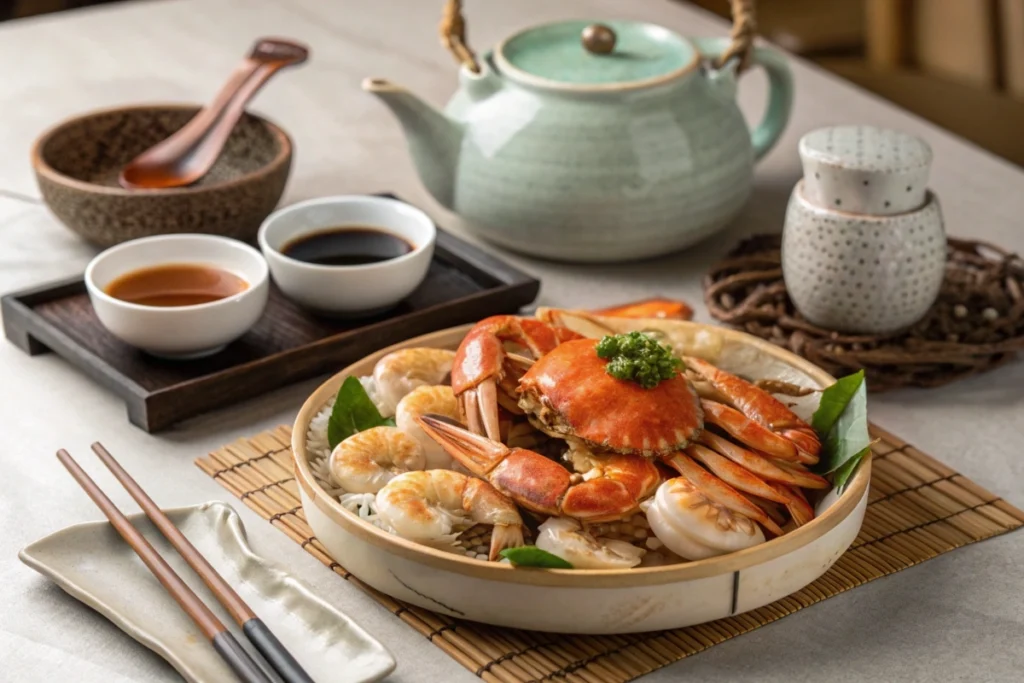Introduction
If you love seafood, japanese food with shrimp and crab will steal your heart. From sushi rolls to hearty stews, Japan boasts a wide variety of dishes featuring these ocean delicacies. Shrimp and crab are prized not only for their sweet, delicate flavor but also for their versatility. Whether you’re preparing a simple shrimp tempura or a lavish crab hot pot, these ingredients can transform an ordinary meal into a feast for the senses.
In Japanese cooking, shrimp appears in everything from sashimi and nigiri to crispy tempura and fried rice. Meanwhile, crab often takes center stage in kani (crab) sushi, hot pots, and even fusion creations like shrimp and crab sushi bake. Both crustaceans bring a unique sweetness to savory dishes. Their texture and taste pair perfectly with rice, noodles, or fresh vegetables.
Ready to expand your seafood horizons? This comprehensive guide covers the reasons why shrimp and crab hold a special place in Japan, popular recipes, essential cooking tips, and more. Along the way, you’ll gain insights that help you select top-quality seafood. If you’re new to Japanese cuisine, explore easy Japanese recipes for new flavors to complement your shrimp or crab-centered dishes.
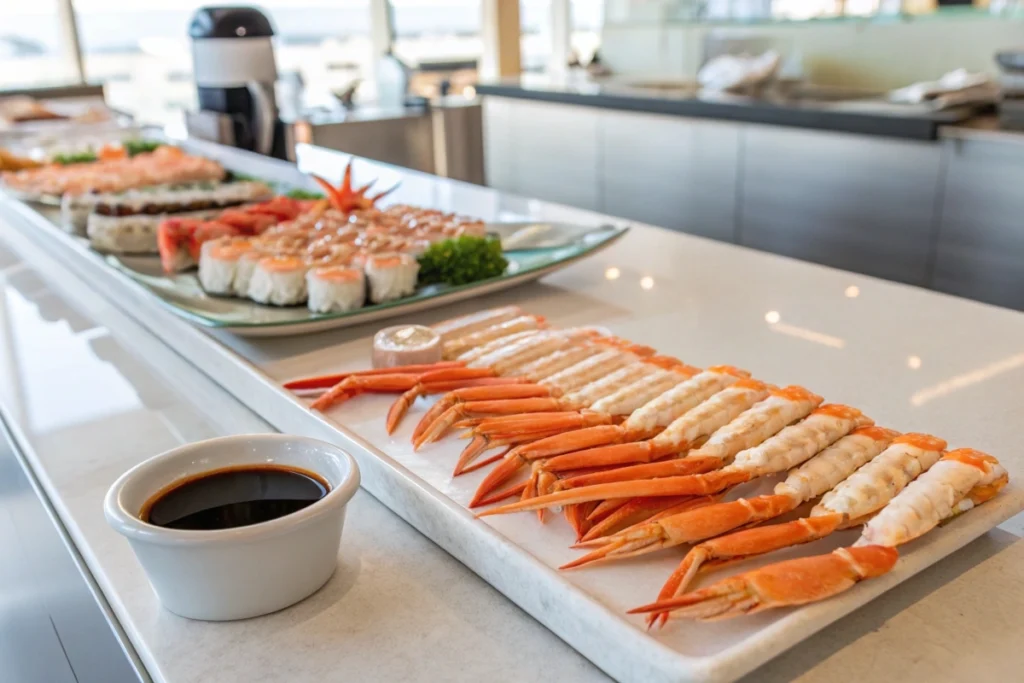
1. Why Shrimp and Crab Feature Prominently in Japanese Cuisine
Seafood is deeply embedded in Japanese food culture, and shrimp and crab rank high on the list of favorites. Both are abundant in the waters surrounding the archipelago, which boasts a long history of fishing and coastal communities. Their distinct flavors and adaptability make them staples in traditional and modern dishes alike.
Nutritional Benefits
Shrimp and crab are high in protein while being relatively low in fat. They contain essential vitamins and minerals such as selenium, zinc, and vitamin B12. Moreover, their natural sweetness can reduce the need for heavy sauces or excessive salt. While moderation is key, these crustaceans can be part of a balanced, health-conscious diet.
Cooking Methods
You’ll find shrimp and crab in various forms:
- Boiled or Steamed: Ideal for enjoying the pure flavor of fresh crustaceans.
- Grilled or Broiled: Locks in juices, giving a smoky edge.
- Tempura: Coats shrimp or crab in a light batter before deep-frying to crispy perfection.
For more seafood inspirations, try a Japanese scallop recipe for more ideas. Each technique highlights the subtle taste and texture of shrimp or crab, ensuring they shine in the final dish.
Cultural Relevance
Crustaceans appear frequently in celebratory meals, from New Year feasts to bento boxes. Their luxury status often symbolizes good fortune or special occasions, making them an integral part of Japanese culinary heritage. With the popularity of these ingredients only growing, there’s no shortage of innovative shrimp and crab recipes to explore.
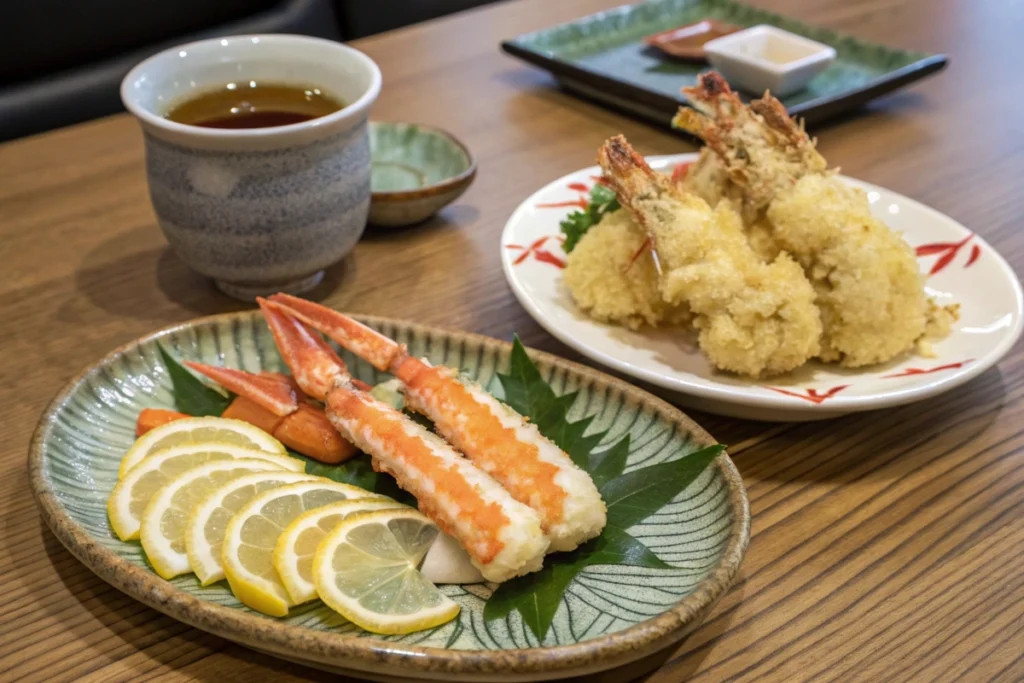
2. Popular Dishes: Sushi Rolls, Sushi Bakes, and More
If you’ve ever tried a crab and shrimp sushi roll or a shrimp sushi bake, you know these dishes skillfully blend simplicity with robust flavors. In Japan, sushi and related staples remain at the forefront of dining culture. Chefs and home cooks alike embrace both traditional and modern interpretations of shrimp and crab.
Sushi Rolls
Classic rolls might highlight crab sticks (often kani kama), but high-end sushi bars use real crab for a sweeter, more delicate bite. Shrimp is a favorite in Ebi Nigiri, featuring lightly cooked shrimp on seasoned rice. For those who crave fusion, a shrimp and crab sushi roll might include avocado, cucumber, or spicy mayo. Some rolls even incorporate a crunchy tempura exterior, adding texture to each bite.
Sushi Bakes
Trendy in recent years, the shrimp and crab sushi bake or my healthy dish sushi bake concept layers rice, seafood, and creamy sauce. Baked until hot and slightly golden, it mimics the flavors of a roll but in a casserole-like format. Ideal for gatherings, it offers a convenient way to serve sushi flavors to a group without rolling individual pieces.
Other Modern Favorites
Away from sushi, chefs utilize shrimp and crab in salads, savory pancakes (okonomiyaki), and even pasta. It’s not uncommon to see crab added to ramen or shrimp starring in a hearty curry. If you’re looking to treat yourself post-meal, discover advanced dessert pairings for a sweet finish.
By blending fresh seafood with creative sauces and textures, Japanese cuisine has elevated simple ingredients like shrimp and crab into iconic dishes. The result? Every dining experience can be an adventure, whether you’re devouring a classic crab roll or savoring a sizzling sushi bake fresh from the oven.
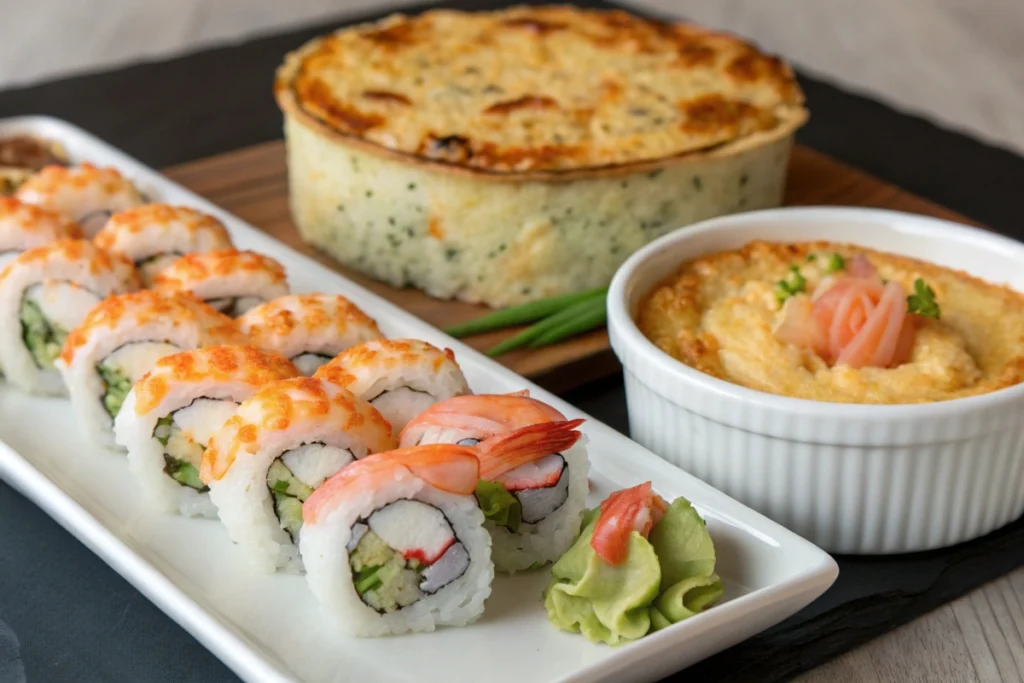
3. How to Choose the Best Shrimp and Crab
The success of any japanese food with shrimp and crab hinges on quality ingredients. Selecting top-notch crustaceans ensures optimal flavor and texture, whether you’re assembling a sushi roll or simmering a stew.
Freshness Indicators
- Smell: Fresh shrimp or crab should have a clean, briny aroma. Strong, off-putting odors often signal spoilage.
- Color: Live crabs usually appear bright or vibrant. Fresh shrimp also exhibit clear, firm bodies.
- Texture: For shelled items, the flesh should be springy, not mushy. Shells that feel excessively slimy may be problematic.
When shopping for crab, you’ll often encounter snow crab, king crab, or even local Japanese varieties like Kegani (hairy crab). Each type offers a unique flavor profile—snow crab’s subtly sweet taste differs from the rich, meaty nature of king crab. Shrimp, on the other hand, ranges from small but sweet ama ebi to large tiger shrimp perfect for grilling.
Handling and Storage
If you don’t plan to cook immediately, store crustaceans on ice or in a cold refrigerator. Wrapping them loosely in damp paper towels can maintain moisture. For extended storage, freezing is possible but can affect texture. Thaw gently in the fridge, never at room temperature.
Cooking Preparation
For crab legs, pre-cooked and frozen are common, requiring only a quick boil or steam. With shrimp, peel and devein if needed, unless your recipe calls for shells-on for added flavor. Want more variety in your seafood cooking? Check out a Japanese fish recipe for variety. Combining different proteins can lead to flavorful, balanced meals.
Ultimately, thoughtful ingredient selection is the cornerstone of any standout shrimp or crab dish. Invest time in seeking fresh, premium options, and let nature’s bounty shine in your Japanese-inspired creations.
4. Shrimp & Crab in Soups, Noodles, and Fried Rice
Beyond sushi and bakes, japanese food with shrimp and crab also makes appearances in comforting soups, hearty noodle dishes, and flavorful fried rice recipes. This broader scope ensures that these crustaceans cater to a variety of palates, from light and subtle to rich and hearty.
Soup and Broth-Based Creations
- Miso Soup: Some regional variations include crab or shrimp for added depth. A small portion goes a long way in enhancing umami.
- Crab Nabe: A hot pot that often includes vegetables, tofu, and noodles, all simmered in a savory broth. Crab shells infuse the soup with a naturally sweet essence.
Noodle Highlights
- Tempura Udon: Crisp shrimp tempura placed atop a bowl of udon noodles. The interplay of crunchy batter and soft noodles creates a textural feast.
- Seafood Ramen: Certain ramen shops specialize in broths studded with crab legs or shrimp. The briny notes complement the salty-sweet soup base.
Fried Rice Variations
Shrimp has long been a favorite fried rice addition, but you can also toss in crabmeat or imitation crab for unique flavor. Combine leftover rice with soy sauce, diced vegetables, and scrambled eggs to create a fast, satisfying meal. For further inspiration, explore how Japanese chicken fried rice can be adapted with seafood twists.
By branching out into noodles, soups, and rice dishes, shrimp and crab take on new forms beyond classic sushi. Whether you prefer a gentle miso soup or a robust seafood hot pot, these versatile crustaceans accommodate any style of Japanese comfort food you crave. Ultimately, variety is the key, making each meal distinct yet equally delicious.
5. Fusion and Modern Twists
The world of japanese food with shrimp and crab isn’t limited to age-old traditions. Contemporary chefs have developed innovative fusion dishes that marry global influences with classic Japanese techniques. These modern twists highlight the versatility of shrimp and crab, appealing to diners seeking fresh, exciting flavors.
East-Meets-West Creations
- Seafood Pizza: Some pizzerias in Japan top their pies with crab sticks, shrimp, and a sweet mayonnaise drizzle. The unlikely blend of cheese and crustaceans forms a surprisingly delicious union.
- Crab-Stuffed Gyoza: Traditional dumplings get a makeover when crabmeat replaces or complements pork fillings. Paired with a soy-vinegar dipping sauce, they offer a delicate, oceanic twist on a classic.
Reimagined Sides and Starters
- Shrimp Croquettes: Influenced by European croquetas, Japanese shrimp croquettes feature creamy, mashed-potato-like fillings. They’re breaded and fried, resulting in a crunchy exterior that reveals a silky shrimp interior.
- Crab Cream Corn Soup: Common in Chinese-Japanese restaurants, this soup merges sweet corn kernels with silky crab and a lightly thickened broth.
By blending styles and techniques, these innovative recipes open new avenues for crustacean lovers. Chefs exploring these modern mash-ups broaden the appeal of shrimp and crab, introducing them to diners who might otherwise stick to more familiar fare.
Final Thoughts
Modern fusions prove that tradition and creativity can coexist beautifully in Japanese cuisine. As culinary boundaries expand, so do the opportunities to experiment with shrimp and crab. Whether you try your hand at a shrimp and crab sushi roll or whip up a batch of crab-filled dumplings, let your imagination roam. The results could surprise you.
History and Context of Japanese Food with Shrimp and Crab
Crustaceans hold a long-standing place in Japanese gastronomy, dating back centuries to when coastal regions depended heavily on the sea for sustenance. Over time, japanese food with shrimp and crab evolved from a subsistence resource into a gastronomic art form, celebrated for its delicate, sweet flavors and cultural significance.
Early Beginnings
Historical texts indicate that shrimp and crab have been part of the Japanese diet since ancient times. Fishermen in coastal villages would haul in the day’s catch, including smaller crustaceans. In these early eras, simple preparations like boiling or grilling over open flames were common. Salt, soy sauce, or miso might have been used to enhance taste, reflecting the limited ingredients then available.
Edo Period Expansion
During the Edo period (1603–1868), the rise of a merchant class led to a blossoming of food culture, particularly in major cities like Edo (modern-day Tokyo). Street vendors sold skewered shrimp and crab in bustling markets. Over time, sushi culture also flourished, introducing fresh shrimp and crab into pressed sushi or nigiri forms. Culinary creativity thrived, with chefs experimenting in response to growing demand for unique dishes.
Modernization and Global Influence
Fast-forward to the Meiji Restoration in the late 19th century. Japan opened its doors to Western ideas, which further expanded cooking methods, including frying techniques that gave birth to tempura. With improved transportation and refrigeration, shrimp and crab could be distributed nationwide, no longer confined to coastal towns. The post-war era intensified globalization, ushering in Western-inspired fusion dishes. This included cheesy seafood gratins and crab-stuffed croquettes.
Current Landscape
Today, shrimp and crab remain iconic, found in everything from exclusive kaiseki (multi-course) dinners to everyday bento lunches. Chefs combine tradition and innovation, leading to dishes like shrimp and crab sushi bake—a modern invention that resonates with home cooks looking for convenience and flavor. Given their inherent sweetness and robust umami, these crustaceans continue to headline both old favorites and new culinary frontiers.

Practical Examples/Use Cases
Scenario 1: Sushi Roll Party
You invite friends over for a DIY sushi party. Everyone gathers around a kitchen island with nori sheets, sushi rice, fresh shrimp, and crab sticks. Some adventurous guests try rolling a shrimp and crab sushi roll, layering avocado, cucumber, and spicy mayo. The result may not be perfect every time, but the communal spirit and vibrant flavors make the evening a success.
Scenario 2: Homemade Sushi Bake
For a weekend potluck, you decide on a shrimp and crab sushi bake. You layer seasoned rice, shredded crab, and diced shrimp in a casserole dish, then top it with a creamy sauce. After a quick bake, you serve it with seaweed sheets for scooping. Everyone raves about how easily it delivers sushi flavors without the meticulous rolling. It’s a modern, crowd-pleasing take on Japanese cuisine.
Scenario 3: Crab Hot Pot for Family Dinner
On a cold winter evening, you surprise your family with a crab hot pot (kani nabe). Using a dashi-based broth, you gently cook vegetables, tofu, and crab legs. Squeals of delight ensue as each person fishes out succulent crab meat from the steaming pot. The meal fosters a sense of togetherness, reminding everyone of seafood’s comforting role in Japanese cooking.
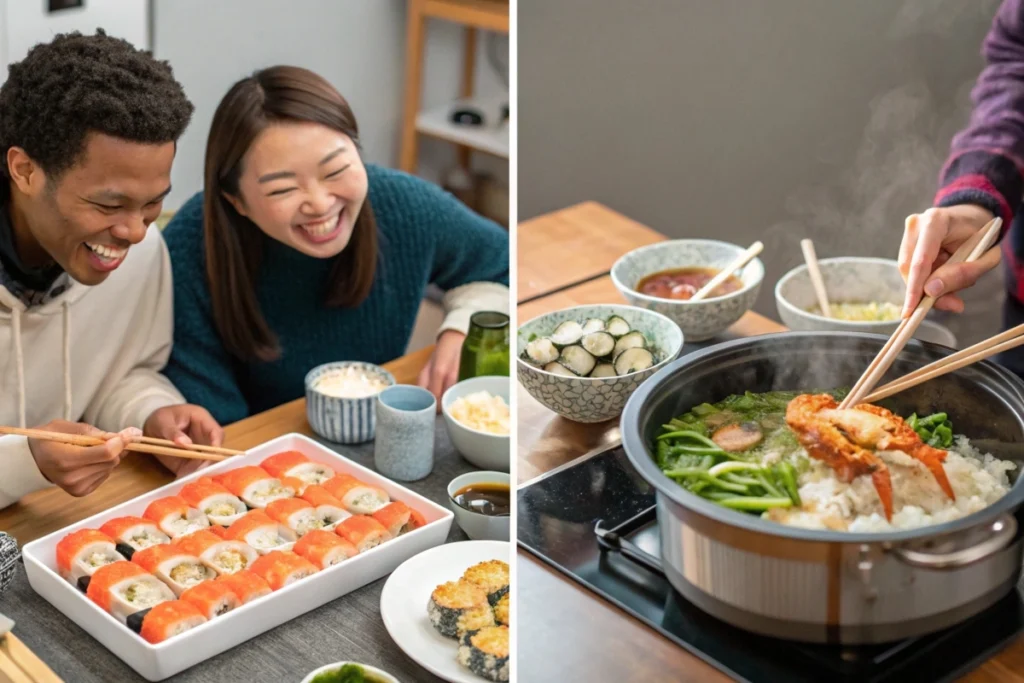
FAQs
Below are common questions about japanese food with shrimp and crab and their role in Japanese cuisine:
- Is shrimp a Japanese food?
Although shrimp is enjoyed globally, it’s indeed a staple in Japanese cuisine. Popular preparations include shrimp tempura, nigiri sushi (ebi), and fried rice. Shrimp’s mild flavor fits well with the delicate balance of Japanese dishes. - Are shrimp and crab good for you?
Yes, both crustaceans are high in protein and low in fat, though portion control and mindful cooking methods (like steaming or grilling) are recommended. They’re also rich in minerals like zinc and selenium, beneficial for overall health. - Is crab a Japanese food?
Crab is widely used in Japanese cooking, but it’s not exclusive to Japan. Many coastal regions worldwide enjoy crab. In Japan, crab is often found in sushi, hot pots, and specialized seasonal feasts—particularly in Hokkaido, famous for its abundant crab harvests. - How do I make a shrimp and crab sushi bake?
Layer cooked rice seasoned with vinegar, then add chopped shrimp and crab (fresh or imitation) mixed with mayo or cream cheese. Top with more sauce or shredded cheese, bake until golden, and serve with nori sheets. It’s similar to the concept of my healthy dish sushi bake but can be tweaked to your preference. - What’s the difference between a shrimp and crab sushi roll and a crab and shrimp sushi roll?
They’re often interchangeable names. Some recipes highlight the crab more than the shrimp or vice versa. In general, both utilize seaweed wraps, sushi rice, and fillings of crab, shrimp, and veggies. - Are these ingredients expensive?
Pricing depends on the variety (e.g., king crab vs. snow crab) and whether shrimp is wild-caught or farmed. Deals at local markets or Asian grocery stores can make them more budget-friendly.
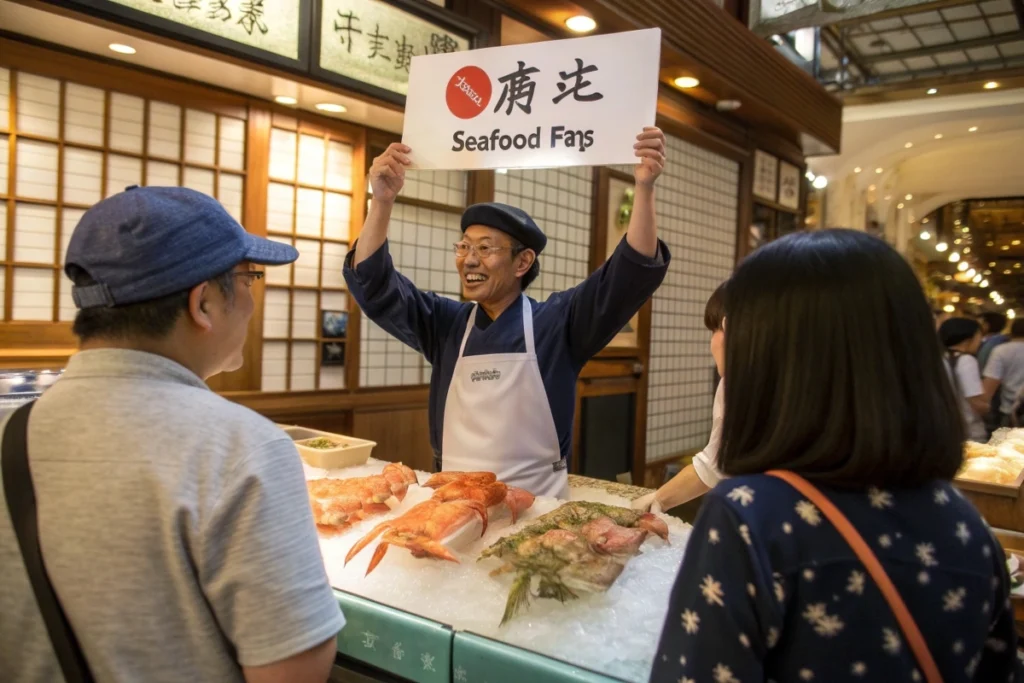
Conclusion
When it comes to japanese food with shrimp and crab, the possibilities span everything from elegant sushi rolls to comforting soups and creative bakes. These crustaceans are integral to Japan’s culinary heritage, yet modern interpretations continue to introduce new fans worldwide. With their delicate sweetness and versatility, shrimp and crab can easily transform simple ingredients—like rice or noodles—into restaurant-worthy dishes.
Whether you’re planning a low-key sushi night with friends or craving a luxurious crab hot pot, the key is quality. Sourcing fresh seafood enhances every bite, while correct preparation ensures you taste their natural briny goodness. Once you’ve mastered a few staples, don’t hesitate to explore fusions and other inventive creations. After all, Japanese cuisine thrives on blending tradition with innovation.
Ready to get cooking? Try making a new shrimp or crab dish this week, and notice how it elevates your mealtime routine. For an extra flourish, pair your crustacean-based dinner with a comforting soup or a unique beverage. If you want more recipe ideas or cooking hacks, check out a Japanese shrimp recipe for added inspiration. Embrace the diverse world of shrimp and crab, and you might just discover your next favorite meal.
